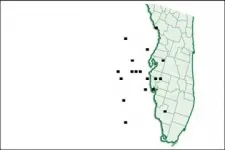(Press-News.org) HOUSTON - The University of Texas MD Anderson Cancer Center's Research Highlights provides a glimpse into recently published studies in basic, translational and clinical cancer research from MD Anderson experts. Current advances include a promising combination therapy for acute myeloid leukemia, understanding mechanisms driving resistance to PARP inhibitors, a therapeutic neoantigen vaccine to treat lung cancer, a novel treatment for triple-negative breast cancer and a new understanding of how telomeres may drive inflammatory bowel disease.
Combination therapy shows promise in mouse models of acute myeloid leukemia
Acute myeloid leukemia (AML) is a cancer that develops in the bone marrow. It is frequently treated with venetoclax, a drug that targets the protein Bcl-2 in combination with a hypomethylating agent, but often, patients develop resistance to venetoclax and then relapse. A research team led by Bing Carter, Ph.D. and Michael Andreeff, M.D, Ph.D., examined the effectiveness of combination therapy with venetoclax and SNDX-50469, a drug that inhibits another protein, menin, which is critical for a certain subset of AML cases. In their mouse model leukemia study, venetoclax alone showed no activity against the disease, but the combination showed strong anti-leukemia activity and prolonged mouse survival. Further investigation is needed to understand the combination's mechanism of action, its appropriate dosage and its clinical effectiveness for patients. Learn more in Blood.
Identifying mechanism of resistance to PARP inhibitors
Cancer cells with mutations in certain pathways may be hypersensitive to targeted therapies against related pathways - a concept known as synthetic lethality. An example is poly ADP-ribose polymerase (PARP) inhibitors, which target DNA repair and are effective in cancers with mutations in other DNA repair genes, such as BRCA1/2. Unfortunately, cancers often develop resistance to PARP inhibitors. To identify these mechanisms of resistance, Mengfan Tang, Ph.D., and Junjie Chen, Ph.D., systematically knocked out more than 18,000 genes using CRISPR/Cas9 gene editing in cells with BRCA2 loss. They identified several genes that, when lost, led to improved survival of BRCA2-deficient cells, even when treated with PARP inhibitors. In particular, they identified loss of cyclin C (CCNC) as critical to survival of the cells, suggesting a novel therapeutic target to overcome PARP inhibitor resistance. Learn more in Nucleic Acids Research.
Therapeutic vaccine targets mutant proteins in lung cancer
Neoantigens are mutant proteins, resulting from genetic alterations in cancer cells, that can be recognized by the immune system as abnormal. MD Anderson researchers have developed therapeutic vaccines containing small neoantigen fragments, or peptides, found in a given patient's tumor. The personalized vaccine is designed to prime the immune system to recognize and attack the tumor. A Phase I clinical trial, led by Fenge Li, M.D., Ph.D., and Gregory Lizée, Ph.D., evaluated these vaccines in patients with non-small cell lung cancer that had progressed with conventional therapies. There were minimal side effects and seven of 24 patients on the study had clinical responses - including one complete response. All responding patients had EGFR mutations, and immune monitoring suggested responses were made against several shared EGFR neoantigens. The results suggest that personalized neoantigen vaccines are safe, feasible and potentially beneficial for patients with advanced lung cancer. Learn more in the Journal for ImmunoTherapy of Cancer.
JNK signaling axis drives triple-negative breast cancer aggressiveness
Triple-negative breast cancer (TNBC) is an aggressive disease that makes up roughly 10% to 15% of breast cancer diagnoses. Because TNBCs have a poor prognosis, understanding the mechanisms that drive tumor growth and progression and finding new treatment targets are major areas of focus in breast cancer research. A team led by Naoto Ueno, M.D., Ph.D., and Takashi Semba, M.D., Ph.D., showed that the JNK/C-JUN/CCL2 signaling axis in TNBC contributes to the formation of an immunosuppressive tumor microenvironment (TME), which plays a critical role in tumor progression. The team confirmed that JNK-regulated CCL2, secreted by tumor-associated macrophages, recruits tumor-infiltrating regulatory T cells to form an immunosuppressive TME that promotes TNBC aggressiveness. The trial's findings offer novel therapeutic strategies for TNBC by demonstrating that the immunosuppressive TME can be reversed using JNK inhibitors. A combination therapy of JNK inhibitors and immune checkpoint blockade may be effective in overcoming TNBC tumor progression. Learn more in Journal of the National Cancer Institute.
Advancing treatment options for inflammatory bowel disease
The ends of chromosomes contain long sequences of repetitive DNA, called telomeres, designed to protect the integrity of genetic information and prevent aging. Research led by Deepavali Chakravarti, Ph.D., and Ronald DePinho, M.D., previously found that telomere disruption can cause increased inflammation by activating a cellular cascade, leading to increased production of the pro-inflammatory factor IL-18. In a new study, the researchers demonstrated for the first time that this telomere-IL-18 circuit also is relevant to the development of inflammatory bowel disease (IBD). In the study, therapeutically restoring telomeres or blocking the pathways downstream of disrupted telomeres was able to reduce IL-18 production. This points to possible therapeutic strategies for treating patients with IBD who currently have limited effective therapeutic options. Learn more in Proceedings of the National Academy of Sciences.
INFORMATION:
In case you missed it
Read below to catch up on recent MD Anderson press releases across the spectrum of cancer research.
* Atezolizumab and bevacizumab show meaningful responses for malignant peritoneal mesothelioma patients
* Novel immunotherapy combination produces durable response in frontline metastatic melanoma
* MD Anderson and Hummingbird Bioscience announce strategic research collaboration to advance innovative immunotherapies
* Study identifies gut microbes associated with toxicity to combined checkpoint inhibitors in melanoma patients
When a hurricane threatens to make landfall, forecasters offer a barrage of informational tools to communicate the risk of it coming through coastal and inland communities, so residents can prepare for its impact. Chief among these tools is the "cone of uncertainty" - a visual depiction of the storm's potential path.
But is the cone doing its job? Studies show that people often misinterpret this popular weather graphic. They don't understand the information it's conveying: the likely path of a storm, and its likelihood to deviate from that path based on historical data. The graphic ...
Americans tend to be far more consumed with national politics than with local politics. As places like Utah, Arizona, Michigan and Maryland gear up to hold local elections this summer and fall, history predicts that they will see an average of 29-37% fewer voters than they would were their elections held "on cycle," in tandem with state and federal elections.
This apparent indifference to local policies can have serious consequences, according to BYU research recently published in the American Political Science Review.
The study found that local governments formed in "off-cycle" years (like 2021) are less responsive to the majority's preferences and more responsive instead to organized interest groups, particularly when the interest groups' desires oppose those of ...
Lessons from Primary Care and Behavioral Health Integration Should Inform Health Care Practices to Identify and Address Patients' Social, Economic Needs
Although interest is accelerating around addressing patients' social and economic needs, effective and sustainable strategies for integrating social care practices into health care delivery have not yet been identified. This paper synthesizes learnings from primary care and behavioral health care integration and translates them into organizing principles with the goal of advancing social care integration practices ...
Heart attack, or myocardial infarction, is one of the leading causes of death worldwide. Although modern surgical techniques, diagnostics and medications have greatly improved early survival from these events, many patients struggle with the long-term effects of permanently damaged tissue, and the 5-year mortality rate remains high. Now, researchers reporting in ACS Nano have developed a minimally invasive exosome spray that helped repair rat hearts after myocardial infarction.
Scientists have explored using stem cell therapy as a way to regrow tissue after a heart attack. But introducing stem cells directly to the heart can be risky because they could trigger an immune response or grow uncontrollably, resulting in a tumor. Therefore, researchers have tried ...
Approximately 642 million people are expected to be diagnosed with diabetes by 2040, with Asians representing more than 55% of cases. Researchers conducted the first large-scale study since the implementation of medical insurance in China to evaluate the complexity and cost of drug therapy for Asian people with diabetes. They used available treatment records from Beijing's medical insurance bureau from 2016 to 2018 and looked at five outcomes, including: 1) quantity of outpatient medications, 2) number of co-morbidities diagnosed, 3) estimated annual cost of the outpatient drug regimen, 4) drug therapy strategies for diabetic patients and 5) the most commonly ...
Summertime is here, and that often means long, lazy days at the beach, water skiing and swimming. Life jackets and swimsuits are essential gear for these activities, but if not dried thoroughly, they can develop a gross, musty smell. Now, researchers reporting in ACS Applied Materials & Interfaces have developed a one-step method to create a buoyant cotton fabric for these applications that is also oil- and water-repellant. Watch a video of the fabric here.
Waterproof and oil-proof fabrics are in high demand for recreational water activities because of their low drag and self-cleaning properties. And while cotton is a popular fabric, it's hydrophilic, so most liquids and dirt can easily mess it ...
Given the aging world population, there is international interest in helping older people live longer and healthier lives. Avoiding unplanned hospital admissions is an important aspect of care for older people. Palapar et al focused on the way primary care practice characteristics influence outcomes such as unplanned hospitalizations, function and well-being. They investigated the variability in older people's outcomes by primary care physician and practice characteristics in New Zealand and the Netherlands. Findings revealed that none of the physician or practice characteristics ...
More than 40% of physicians in the United States reported at least one symptom of burnout, which is particularly high among family physicians. This study examined a nationally-representative sample of family physicians to determine whether physician race-ethnicity was associated with burnout among a nationally-representative sample of family physicians. Of the 3,0916 physicians studied, 450 (15%) were from racial-ethnic groups underrepresented in medicine (UIM), which include Blacks/African Americans, Hispanics/Latinos, American Indians and Pacific Islanders who together comprise 30-35% of the general population yet account for only 12.4% of family physicians. The study findings support the researchers' hypothesis ...
Drs. Alicia Cohen and Emilia De Marchis provide commentary on three articles in this issue of Annals of Family Medicine, specifically Greenwood-Ericksen et al's research on Michigan's Federally Qualified Health Centers; Hoeft et al's special report about translating lessons learned from behavioral health integration into the social care realm; and Fessler et al's narrative about how they as medical students stepped away from their medical clerkships to act as community volunteers for people experiencing homelessness during the COVID-19 pandemic. All three articles serve as a timely call to action, reminding those in health care that work remains to meet the needs of patients, particularly in screening for and intervening on identified social risks. The urgency of this work has only been ...
From domoic acid poisoning in seabirds to canine distemper in raccoons, wildlife face a variety of threats and illnesses. Some of those same diseases make their way to humans and domestic animals in our increasingly shared environment.
A new early detection surveillance system for wildlife helps identify unusual patterns of illness and death in near real-time by tapping into data from wildlife rehabilitation organizations across California. This system has the potential to expand nationally and globally. It was created by scientists at the University of California Davis' School of Veterinary Medicine with partners at the California Department of Fish and Wildlife ...



